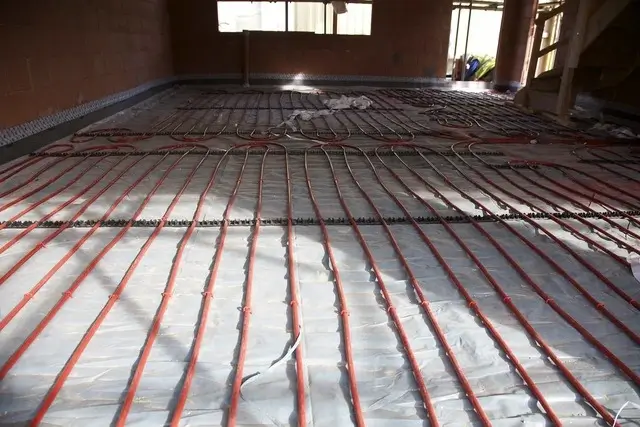When it comes to radiant warmth and unprecedented comfort, Underfloor Heating (UFH) stands as a pinnacle of modern engineering. With an array of applications ranging from residential spaces to sprawling commercial complexes, Underfloor heating has redefined what it means to be both energy-efficient and luxurious. In this comprehensive guide, we’ll explore the intricacies of UFH systems, their advantages, and how to implement them flawlessly in your project.
Understanding the UFH Mechanism
Underfloor Heating operates by circulating warm water through a network of pipes laid under the floor. This transforms the floor surface into a large, energy-efficient radiator, providing consistent warmth across the entire room. Unlike traditional heating solutions, which concentrate heat at specific points, UFH offers a more uniform distribution of heat.
Types of UFH Systems
Wet UFH Systems: Utilizes a network of pipes to circulate hot water from the central heating system.
Electric UFH Systems: Relies on electric coils laid under the floor to generate warmth.
Why UFH Systems Are Unbeatable
Energy Efficiency
UFH systems typically operate at lower temperatures compared to conventional radiators, yet they distribute heat more effectively. This results in reduced energy consumption and, ultimately, lower utility bills.
Optimal Comfort
With UFH, you can say goodbye to cold spots and fluctuating temperatures. The system ensures a uniformly warm floor, making every step you take a literal warm welcome.
Aesthetic Freedom
Say goodbye to bulky radiators and unsightly heating equipment. With UFH, all components are neatly tucked away beneath the floor, giving you more room for interior design creativity.
Choosing the Right UFH System for Your Project
To achieve the best results, consider the following factors:
- Flooring Material: Materials like ceramic tiles conduct heat excellently, making them ideal for UFH systems.
- Insulation: Good insulation is crucial to prevent heat loss and improve the system’s efficiency.
- Room Size: Larger spaces may require more advanced systems or multiple heating zones.
Installation Process
A well-executed installation process is pivotal for optimal UFH performance. Therefore, it is recommended to employ experienced professionals who can install the system with precision.
- Initial Assessment: Evaluation of the room dimensions and layout.
- Pipe Laying: Placement of heating pipes according to the design plan.
- System Testing: Conduct a thorough test to identify any potential issues.
- Floor Installation: Once the system is confirmed to be fault-free, the final flooring layer is installed.
Maintaining Your Underfloor Heating System
Maintaining a UFH system is generally hassle-free. Annual inspections and timely repairs can elongate the system’s life and maintain its efficiency.
- Cleaning: Keeping the system clean ensures better performance.
- Regular Check-ups: Professional inspections can preemptively address issues.
The Cost Factor: A Worthwhile Investment
While the initial setup costs of an Underfloor Heating (UFH) system can be considerable, it’s important to see this as a long-term investment. When you factor in the long lifespan and lower operational costs, UFH systems often provide a greater return on investment compared to traditional heating solutions. Additionally, the enhancement in property value cannot be overlooked, making UFH an economically viable option for future-proofing your home or commercial space.
Integration with Renewable Energy Sources
One of the most remarkable features of UFH is its compatibility with renewable energy sources. Whether it’s solar water heaters or geothermal energy systems, UFH can be seamlessly integrated, further boosting its eco-friendly credentials. By opting for a sustainable energy source, you’re not just cutting down on your energy bills but also making a positive environmental impact.
Safety and Health Benefits
Traditional heating systems can often circulate dust and allergens throughout a space. UFH, on the other hand, offers a cleaner form of heating. By minimizing air circulation, it helps to reduce the spread of airborne particles, providing a healthier living environment. Additionally, the absence of hot surfaces or sharp edges as seen in traditional radiators makes UFH a safer choice for households with children and pets.
Upgrading an Existing Space: Is It Feasible?
Many wonders if UFH is only suitable for new constructions. The answer is no. Modern UFH systems are designed to be retrofitted into existing structures with minimal disruption. With the availability of low-profile systems, the height of the existing floor doesn’t need to be significantly altered, making it a feasible upgrade for most properties.
Local Regulations and Standards
Before embarking on your UFH installation project, it’s crucial to be aware of local building codes and regulations. Ensuring that your system meets these standards will not only guarantee efficient performance but also avoid any legal complications down the line.
UFH – The Future is Warm and Bright
Underfloor Heating (UFH) is no longer a luxury; it’s a smart choice for anyone looking for efficient, consistent, and safe heating solutions. As technology advances, UFH systems continue to evolve, becoming even more efficient and adaptable. So whether you’re building a new home, revamping an existing space, or running a commercial property, the UFH system holds the promise of comfort, efficiency, and sustainability. Now is the time to make this future-ready investment.
Elevate Your Lifestyle with UFH
When considering all the benefits and efficiencies of Underfloor Heating, it’s clear that UFH is not just a trend but an enduring solution for modern, luxurious, and sustainable living. The initial costs are often outweighed by long-term benefits, including increased property value and drastically reduced energy bills. Isn’t it time you make the switch?
